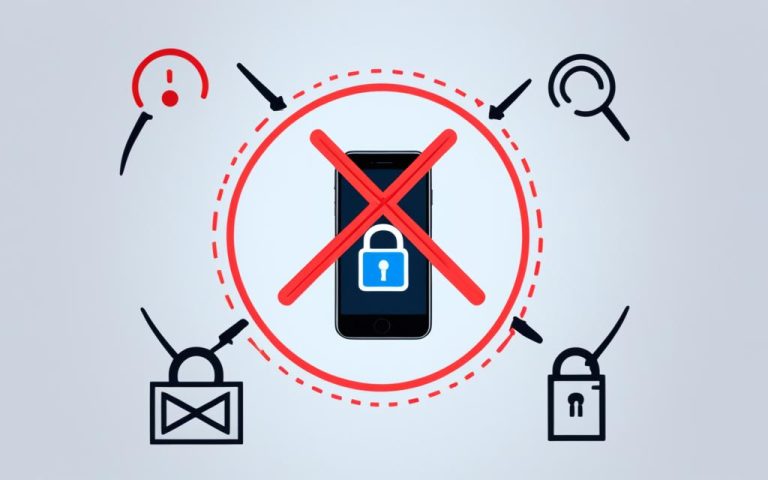Small businesses often face cyber threats, with 43% experiencing data breaches. Many use free or no security, making them easy targets. It’s vital for small offices to focus on network security to keep data safe and defend against threats.
To secure a small office network, a detailed plan is needed. A 13-step guide helps implement security well1. It includes steps on password management, multi-factor authentication, and cloud security to fight cyber threats.
Key Takeaways:
- Implement a comprehensive 13-step process for securing small office networks1.
- Increase password strength requirements and enforce regular rotation1.
- Implement multi-factor authentication to enhance security1.
- Adopt a least privilege access strategy for employees1.
- Utilize cloud security measures such as CASB and secure browser applications1.
By following these guidelines, small offices can lower their risk of cyber threats. It’s crucial for businesses to invest in network security and stay ahead in protecting their systems.
Understanding Your Network Infrastructure
Before you start securing your small office network, it’s key to know your network setup and what devices connect to it. By sorting your network into three main parts – devices, cloud services, and endpoints – you can spot weak spots. This helps in making a strong security plan for all areas.
Infrastructure Devices:
These devices are the core of your network, like Wi-Fi routers, switches, and firewalls. They make sure your network works well, handle traffic, and keep out threats. With good design, your network runs smoothly, making data sharing and communication easy2. Choosing top-notch devices is vital for a secure network that can grow with your needs2. Standardizing settings and using future-proof methods helps manage and fix issues as your network grows2.
Cloud Services:
Many small offices use cloud services for things like email and sharing files. But, it’s important to check how secure these services are. Only 45% of small offices use encryption, leaving many open to threats3. Make sure your cloud services have strong security to protect your data.
Endpoints:
Endpoints are all devices on your network, like laptops, phones, and smart devices. Keeping these secure is key to stop unauthorized access and cyber threats. A good network setup lets employees work remotely safely, with the right security steps in place2. Regular checks help find and fix weak spots, like unknown devices or gaps in security2. Adding two-factor authentication (2FA) can also lower the chance of unauthorized access3.
Knowing your network setup is the first step to strong security. By looking at your devices, cloud services, and endpoints, you can spot and fix weak spots. Use data from trusted sources23 to see why a strong network and good security are crucial.
| Statistical Data | Source |
|---|---|
| Effective network infrastructure design enhances network efficiency, enabling seamless data flow and communication. | 2 |
| Network infrastructure design and managed network operations center (NOC) services protect against malicious cyber threats. | 2 |
| Well-designed network infrastructure supports remote work and ensures necessary cybersecurity safeguards. | 2 |
Securing Routers and Switches
Routers and switches are key to network security, connecting devices and ensuring data flows smoothly. But, if not secured, they can be weak spots for cyberattacks. It’s vital to protect these devices to keep your network safe. We’ll look at how to secure routers and switches to protect your network.
Start by changing the default password. Default passwords are easy for hackers to find. A strong, unique password keeps unauthorized users out. Update your password often to keep it effective4.
Disable remote administration to add another layer of security. This feature lets users manage devices from afar, but it’s a risk. By turning it off, you limit access to the local network, reducing security risks4.
Keep routers and switches in a secure place. Put them in a locked room or closet to limit access. This stops tampering or theft, keeping your network safe4.
Update your devices regularly with the latest firmware and software. These updates fix security issues and improve device performance. Always check for updates and apply them quickly to keep your network secure4.
Setting up access controls is another way to secure routers and switches. This limits who can change settings, reducing risks of unauthorized actions. It helps prevent security breaches and mistakes4.
Consider adding security features like IDS and firewalls for extra protection. IDS watches for suspicious network traffic and alerts you to threats. Firewalls block unauthorized access by setting strict rules, boosting security4.
Importance of Firewalls in Network Security
Firewalls are key to keeping networks safe by watching and controlling both incoming and going out traffic. They act as a shield, keeping networks safe from unauthorized access and threats. For over 25 years, firewalls have been a crucial part of keeping networks secure5.
Most computers and security tools already have firewalls, showing how important they are for network safety5. A firewall is the first defense against outside threats, stopping bad attacks and keeping sensitive info safe.
Firewalls with special features can stop malware, keeping networks safe and secure5. They filter out bad traffic and attacks at different levels, stopping security breaches before they happen.
Without firewalls, networks are easy targets for hackers, making firewalls a must-have in cybersecurity5. These tools protect against unauthorized access, keeping networks safe, private, and working well.
There are many types of firewalls, each with its own way to secure networks5. Next-generation firewalls are especially good at fighting new threats by understanding and controlling apps, making networks safer.
Firewalls stop attacks at the app level, fight malware, and protect against phishing5. They check all traffic to and from the network, keeping data safe from cyber threats.
Firewalls also protect data from leaving the network without permission5. This helps stop social engineering attacks, keeping sensitive info safe.
Companies get faster response times and better traffic management with firewalls5. By watching and controlling traffic, firewalls make networks run smoother and stay secure.
For firewalls to work well, they need regular updates, to work with antivirus tools, and to back up data5. Keeping firewalls updated helps protect against new threats and keeps networks strong.
For the best network security, use allowlists to limit access and network segments5. These steps make networks even safer and stop unauthorized access.
| Importance of Firewalls in Network Security |
|---|
| Firewalls have been a fundamental part of network security systems for over 25 years5 |
| Most operating systems and security software come with pre-installed firewalls5 |
| Firewalls with integrated intrusion prevention systems can effectively block malware and application-layer attacks5 |
| Networks without protection are vulnerable to attacks, emphasizing the importance of firewalls in cybersecurity5 |
| Different types of firewalls include packet filtering, proxy service, stateful inspection, and next-generation firewalls5 |
| Next-generation firewalls provide application awareness and control, enhancing network security against evolving threats5 |
| Firewalls are essential for blocking application-layer attacks, combating malware, and securing networks against phishing attacks5 |
| Having firewalls in place enhances security levels for vulnerable networks, preventing unauthorized access and blocking outflowing data in case of social engineering attacks5 |
| Businesses and organizations benefit from firewalls by enjoying faster response times and improved traffic load management5 |
| Proper setup and maintenance of firewalls are crucial for network security, including regular updates, antivirus software integration, and active data backups5 |
| Using allowlists to limit network accessibility and segmenting networks internally are recommended best practices for network security5 |
Using VPNs for Enhanced Network Security
With more people using digital tech and working from home, keeping networks safe is key. A Virtual Private Network (VPN) is a great way to boost security. It makes a safe, private path for data to travel, keeping sensitive info safe from prying eyes.
VPNs use strong encryption like AES6 to keep data safe as it moves. They come in different types, each with its own level of security. This means you can pick the right one for your needs.
For those working remotely or using public Wi-Fi, VPNs are a must. They shield your data from cyber threats. Remote Access VPNs6 are perfect for individuals needing secure links to their work networks from anywhere.
Site-to-Site VPNs6 connect different networks safely. They’re great for companies linking offices or data centers. These VPNs make sure data moves securely, keeping communication and data sharing safe.
VPN encryption is key to keeping data safe in private networks. AES encryption6 is a top choice for secure communication, keeping data safe from hackers.
Benefits of VPNs for Enhanced Network Security
VPNs bring many benefits to network security:
- They create a secure tunnel over the internet, keeping data safe and private7.
- They let remote workers safely connect to the company network, making work secure from anywhere7.
- There are different VPN types for various security needs, like remote access or site-to-site connections7.
- VPNs help businesses follow data protection laws, keeping sensitive info safe7.
- They lower the risk of cyber attacks by protecting data and keeping it private on public networks7.
In summary, VPNs are essential for network security. They make sure data is encrypted and safe, which is crucial for remote work and public Wi-Fi use. It’s important to pick a trusted VPN and set it up right for secure connections6.
Network Access Control for Restricted Access
Network access control (NAC) solutions are key to keeping networks safe and secure. They make sure only approved users can get in and stop unauthorized devices. NAC checks devices to see if they meet security standards before giving them access. This means checking for the latest antivirus software and following security rules.
Using user-based authentication and Dynamic Pre-Shared Key (DPSK) makes Wi-Fi safer and better for users.
Enhanced Security with Network Access Control
NAC solutions bring many benefits to network security. A lot of organizations use them to boost their security8. NAC finds unknown devices that shouldn’t be on the network9.
NAC helps fight against BYOD and IoT security risks, protecting the network8. It watches over network activity and stops unauthorized actions, lowering the chance of malware and cyberattacks9.
With NAC, companies can set rules to stop suspicious actions and isolate devices. This cuts down on cyber threats without needing IT help9. Data shows NAC helps with network segmentation and traffic watching, making the network safer and run better8.
Meeting Compliance Requirements with NAC
NAC solutions boost security and help meet data privacy laws like GDPR, HIPAA, and SOX10. They help with secure connections for guests, temporary workers, BYOD, and IoT devices. This makes it easier for companies to follow the law10.
ClearPass OnBoard automates setting up mobile devices for safe network connections. It cuts down on IT work while making sure devices are secure and follow the rules10. Data shows knowing how the network is used is key to making NAC work well and keeping the network safe8.
Cloud Access Security for Data Protection
Cloud access security broker (CASB) solutions are key in keeping sensitive data safe and following data privacy laws. They give companies control over apps used outside the network to access data. This helps protect valuable information.
One main feature of CASB is app visibility. It lets businesses see and track apps used by users, both approved and not approved. CASB can tell the difference between approved and unapproved cloud services. This helps in setting the right policies for each use case11.
CASB also has automated policies. These policies can allow or block actions, prevent unauthorized uploads, and limit app use11. This automation ensures consistent and strong security, lowering the risk of data breaches and unauthorized access.
Managing collaboration is another key part of CASB. CASB can quickly scan files to find sensitive data and manage how it’s shared11. This keeps sensitive info safe and shared only with those who should see it, reducing the chance of data leaks.
Moreover, CASB solutions have advanced threat protection like real-time proxy and cloud sandboxing11. These features help spot and stop threats, making cloud data safer.
Gartner expects 60% of companies to use CASB by 2022, up from less than 20% now12. The rise in cloud use and the need for better security are driving CASB demand. CASB is key for following laws like HIPAA and avoiding big fines for not following them12.
CASBs offer strong data security with features like access controls and encryption12. These tools help protect cloud-stored data and make sure only the right people can see it.
Using CASB, companies can keep an eye on and control how sensitive files are shared across different cloud services12. This reduces the risk of data leaks, keeping data safe from unauthorized access or sharing.
CASBs are also great at finding and fixing cloud service misconfigurations that could be attacked12. With CASB, companies can secure and set up their cloud services right, keeping their security strong.
By using CASB, companies can stop cyber attacks on cloud services with strong security rules and watch for suspicious activity12. This approach improves data protection and helps manage security risks well.
Protecting cloud data is a top concern for companies due to more data, remote work, and the need for strong security13. With more data, companies must keep it safe, secure, and easy to get to when needed.
Cloud security is a team effort between providers and users, with each side responsible for their part13. Companies must put in strong security steps to protect their data and follow the law and industry rules13.
Cloud data security has its challenges, like not knowing what’s happening with data on other servers, confusion over who’s responsible, and dealing with threats13. To overcome these, companies need advanced security tools like CASB for full protection.
Cloud data security has many benefits13. It gives better insight into data use, makes backups easy, helps with following laws, encrypts data, cuts costs, and improves in finding and handling incidents. Cloud security solutions help companies protect their data and use it for growth and innovation.
Google Cloud provides secure settings and advanced security tools to help companies keep their cloud data safe13.
In conclusion, CASB solutions help companies protect their data and follow data privacy laws. CASB gives visibility into app use, automated policies, and tools for managing collaboration and fighting threats. With more companies using CASB and the importance of cloud data security growing, companies can keep their sensitive information safe and reduce security risks.
Employee Education on Network Security
Teaching employees about network security is key for small office networks14. With more people working from home, it’s vital to keep them informed about security14. This helps protect the network from threats.
Teaching the value of strong passwords is crucial14. Most cybersecurity issues come from human mistakes14. By teaching employees how to make strong passwords, companies can lower the risk of data breaches.
Training should also cover spotting threats and safe online habits14. With hackers attacking every 39 seconds14, employees need to know the risks they face14. Training should include how to spot phishing, safe browsing, and handling suspicious emails or links.
It’s also key to teach employees how to report security issues and what to do if they suspect a device is compromised14. Encouraging them to report incidents helps address threats fast14. This makes the whole team work together to protect the company’s data.
FEMA’s IS-0906 course is a great way to start training14. It’s just one hour long and covers important security tips14. Companies should also make sure employees use company devices for work, especially for those working remotely or on public Wi-Fi14.
Regular backups are also important for keeping data safe14. This way, if a device fails or gets hacked, you can still get back important data14.
Employee Education on Network Security Checklist:
- Include network security training in employee onboarding and ongoing training.
- Emphasize the importance of strong passwords and how to make them.
- Teach employees to spot threats and stay safe online.
- Have a plan for reporting security issues and what to do if a device is at risk.
- Encourage using company devices for work, especially for remote workers and those on public Wi-Fi.
- Have a plan for regular backups of important data.
By focusing on employee training, companies can build a culture of security awareness1516. With cyber threats on the rise and employees being key to security15, it’s crucial to educate them on network security1516. This helps protect sensitive data and keeps the company’s reputation safe1516.
Small Business Network Security Importance
Small businesses are often targeted by cyberattacks, making up about one-third of all data breaches17. Many struggle with limited budgets for network security17. Yet, it’s vital for them to focus on security to protect things like customer data and intellectual property.
In 2021, 61% of small and medium-sized businesses faced cyberattacks17. Also, 47% of those with under 50 employees didn’t have a cybersecurity budget17. These numbers show the need for small businesses to invest in security to defend against threats.
Small business owners often think their size makes them less of a target for cyberattacks17. But, 59% of those without cybersecurity think they’re too small to be targeted17. This belief can make their networks vulnerable to big breaches.
There are affordable solutions for small businesses that are effective17. Options like Aruba ClearPass and Forescout Platform are great for small to medium-sized businesses17. FortiNAC by Fortinet and Cisco’s Identity Services Engine (ISE) also offer strong security features17.
By choosing the right network security solutions, small businesses can lower the risk of data breaches17. Even with limited budgets, it’s important to focus on security to protect operations and gain customer trust.
| Statistical Data | Reference |
|---|---|
| 61% of small and medium-sized businesses were targeted by cyberattacks in 2021 | 17 |
| 47% of businesses with fewer than 50 employees lack a cybersecurity budget | 17 |
| 59% of small business owners with no cybersecurity measures believe their business is too small to be targeted | 17 |
For small businesses, network security is key to protecting assets, reducing data breach risks, and ensuring success17. By focusing on security, they can grow and build trust with customers.
Top 10 Network Security Best Practices for Small Businesses
Small businesses are often seen as easy targets for cyber attacks because they don’t invest as much in security as big companies do. To keep your business safe and protect your important data, you need to follow good network security practices. These tips will help make your network stronger against cyber threats and keep your business running smoothly. Here are the top 10 network security best practices for small businesses:
| Best Practice | Description |
|---|---|
| 1. Raise network security awareness among employees | Train your employees to spot and report cyber threats to stop internal weaknesses. (Statistical data18) |
| 2. Use Zero Trust methodology | Use the Zero Trust method by adding technologies like multi-factor authentication, identity and access management, and encryption. (Statistical data19) |
| 3. Deploy network security solutions | Put in place network security tools like firewalls, IDS, NAC, anti-malware, email and web filters. (Statistical data19) |
| 4. Keep software and devices updated | Update your software and devices often to fix weaknesses and defend against attacks. (Statistical data19) |
| 5. Protect your website with SSL certificates | Secure your website with SSL certificates and use HTTPS to keep data safe between your site and users. (Statistical data19) |
| 6. Perform penetration testing | Do regular penetration tests to find and fix network weak spots before hackers do. (Statistical data19 and18) |
| 7. Use VPN for secure connections | Use Virtual Private Networks (VPNs) for secure connections, especially for remote work, to keep data safe from unauthorized access. (Statistical data19 and18) |
| 8. Have a disaster recovery plan | Make and keep a disaster recovery plan ready to lessen damage and keep your business going after a cyber attack. (Statistical data19) |
| 9. Create a network security policy | Set up a detailed network security policy that tells employees how to keep the network safe. (Statistical data19) |
| 10. Regularly conduct security audits and assessments | Do security checks often to find weak spots and make sure you follow the rules and best practices. (Statistical data19) |
Following these network security tips will help small businesses fight off cyber threats and protect their valuable data. By focusing on network security, you can keep your business’s data safe, secure, and available. This builds trust with your customers and stakeholders. For more info on network security for small businesses, click here, here, and here. (References: 1, 2, and 3)
Conclusion
For small office networks, it’s key to have strong network security to fight off cyber threats and keep data safe. In recent years, many small companies have faced cyber attacks, with about 80% falling victim20. The cost of cybercrime hit USD 2.7 trillion in 2018, with small firms paying 43% of that20. But, firms that work with security partners are three times more likely to avoid cyber attacks20.
Having a solid security policy is vital for protecting your network. It needs everyone in the company to be on board21. A good policy keeps info, systems, employees, and the company safe21. To make a strong policy, leaders must assess risks, spot important info and systems, follow laws and ethics, and set security goals21. Getting staff involved in making the policy makes it more effective and gets them more interested21. Leaders should include people from all levels and even outside experts to get different views21.
Keeping your wireless network secure is also crucial. WPA2 is common, but WPA3 is better against threats22. WPA3 uses Simultaneous Authentication of Equals (SAE) for better security22. Other ways to keep Wi-Fi safe include using MAC address filters to block unknown devices22. Wi-Fi can be at risk from attacks like Man-in-the-Middle and Denial of Service22. To fight these, keep your security and encryption up to date22. For home Wi-Fi, use strong passwords and WPA3 for the best security22. Also, update your router’s firmware often and use WPA2 or WPA3 encryption22. Using a VPN on public Wi-Fi keeps your internet use private and safe22.
Keeping business Wi-Fi safe is key to protecting important data. Companies should use WPA3 and strong passwords to boost security22. Advanced steps like watching internet traffic and using strong firewalls are needed to protect business Wi-Fi22. Working together with other companies can help share costs and improve security efforts22.
By following these steps, small offices can better protect against cyber threats and keep their data safe. Making network security a top priority is vital for small businesses to keep customer trust and ensure their networks stay safe and open.
Tips for Successful Implementation
Protecting small office networks is key to keeping sensitive data safe and fighting off cyber threats. Here are some top tips for a successful setup:
- Understand your network infrastructure to spot weak spots and pick the right security steps23.
- Secure routers and switches by setting strong passwords, turning off unused services, and controlling access23.
- Use firewalls and encryption like Triple Data Encryption Standard (3DES), AES, and RSA to shield data23.
- Think about a VPN for safe remote work and data sharing23.
- Put in network access control (NAC) to keep your network safe, letting only approved devices and people in2324.
- Teach employees about keeping the network safe, making strong passwords, spotting phishing, and keeping software updated2324.
- Have a disaster recovery plan to cut downtime and get back up and running fast after a security issue or system crash23.
By focusing on network security and following these steps, small offices can build a strong shield against cyber threats. This helps them succeed over the long term23.
FAQ
What are the guidelines and best practices for implementing security on small office networks?
Small office networks can boost their security by following certain guidelines and best practices. This includes understanding the network setup, securing routers and switches, and using firewalls. It also means considering VPNs, educating employees, and having a disaster recovery plan ready.
How do I understand my network infrastructure?
To get to know your network infrastructure, break it down into three main parts. These are infrastructure devices like Wi-Fi, routers, and switches, cloud services for things like email and file sharing, and endpoints like laptops and smartphones. Make sure to regularly check your network for weak spots and think about getting outside help for extra security checks.
How do I secure routers and switches?
To make routers and switches more secure, start by changing their default passwords. Also, turn off remote access and keep them in a safe place. This could be a locked room or closet to stop unauthorized access.
What is the importance of firewalls in network security?
Firewalls are key in keeping networks safe. They watch and control what data goes in and out. They add a strong layer of defense and can be either hardware or software. Think about adding more tools like systems to detect and stop intrusions, manage security events, and prevent data loss.
How can VPNs enhance network security?
VPNs make it hard for hackers to intercept and read data by creating secure connections. They’re especially useful for remote workers or those using public Wi-Fi. Pick a VPN that fits your network and set it up to keep connections safe.
What is network access control and why is it important?
Network access control (NAC) solutions only let authorized users in. They check devices for security before letting them join the network. This is key to stop unauthorized devices and make sure everyone follows the security rules.
How can cloud access security protect my data?
Cloud access security broker (CASB) solutions give you control over apps that access company data from outside. They stop unauthorized access to sensitive data and help meet data privacy laws like GDPR and CCPA.
Why is employee education important for network security?
Teaching employees about network security is key to keeping your network safe. Training should cover spotting threats, safe online habits, and the importance of strong passwords. Make sure employees know how to report security issues if they suspect a device is compromised.
Why is network security important for small businesses?
Small businesses are often targeted by cybercriminals and suffer a lot of data breaches. Even with limited budgets, they must focus on network security to protect data, customer info, and intellectual property.
What are the top 10 network security best practices for small businesses?
The top 10 network security tips for small businesses include making employees aware of security, using Zero Trust, and deploying security tools like firewalls and intrusion detection. Also, keep software and devices updated, protect websites with SSL, test for vulnerabilities, use VPNs, have a disaster recovery plan, and create a security policy.
Why is network security essential for small office networks?
Network security is crucial for small office networks to protect sensitive data. It helps prevent data breaches and keeps the network safe and accessible. This builds trust with customers and clients.
What are some tips for successful network security implementation on small office networks?
To make network security work on small office networks, start by understanding your network setup. Secure routers and switches, and use firewalls and other tools. Think about VPNs and network access control, educate your team, and have a disaster recovery plan. Putting security first is key for your network’s long-term success.
Source Links
- https://www.esecurityplanet.com/networks/how-to-secure-a-network/ – Network Protection: How to Secure a Network in 13 Steps
- https://www.connectwise.com/blog/business-continuity/network-infrastructure-design-best-practices – Network Infrastructure Design: Planning & Implementation | ConnectWise
- https://www.lenovo.com/us/en/glossary/secure-network/ – What is a Secure Network? How to Secure Your Wireless Network
- https://www.enterprisenetworkingplanet.com/security/how-to-secure-a-network/ – How to Secure Your Network in 6 Simple Steps
- https://www.datto.com/blog/what-is-a-firewall-and-why-is-it-important-in-cyber-security/ – What Is a Firewall and Why Is it Important in Cyber Security? | Datto
- https://thedatascientist.com/the-role-of-vpns-in-enhancing-private-network-security/ – The Role of VPNs in Enhancing Private Network Security – The Data Scientist
- https://dig8ital.com/post/network-security-vpn/ – Maximizing Online Security with VPN: Protecting Your Network | dig8ital
- https://www.varonis.com/blog/network-access-control-nac – What Is Network Access Control? Explaining NAC Solutions
- https://www.fortinet.com/resources/cyberglossary/what-is-network-access-control – What Is Network Access Control (NAC) ? | Fortinet
- https://www.arubanetworks.com/faq/what-is-network-access-control/ – What is Network Access Control (NAC)?
- https://www.zscaler.com/resources/security-terms-glossary/what-is-cloud-access-security-broker – What Is a Cloud Access Security Broker (CASB)?
- https://www.proofpoint.com/us/threat-reference/casb – What Is CASB (Cloud Access Security Broker)? – Definition | Proofpoint US
- https://cloud.google.com/learn/what-is-cloud-data-security – What is cloud data security? Benefits and solutions
- https://preyproject.com/blog/how-to-educate-employees-about-cybersecurity – How to train employees on cyber security | Prey
- https://www.techtarget.com/searchsecurity/definition/security-awareness-training – What is Security Awareness Training? | Definition from TechTarget
- https://www.cybsafe.com/blog/7-reasons-why-security-awareness-training-is-important/ – 7 reasons why security awareness training is important in 2023
- https://www.turn-keytechnologies.com/blog/implementing-network-access-control-for-small-businesses-a-simple-guide – Implementing Network Access Control for Small Businesses: A Simple Guide
- https://purplesec.us/protect-business-cyber-attacks/ – 5 Ways To Protect Your Business From Most Cyber Attacks | Purplesec
- https://myfastech.com/network-security-best-practices-for-small-businesses/ – Network Security Best Practices for Small Businesses – Fastech Solutions
- https://www.crowncomputers.com/small-business-network-security/ – Network Security Strategies for Small Businesses
- https://nces.ed.gov/pubs98/safetech/chapter3.asp – Development and Implementation, from Safeguarding Your Technology, NCES Publication 98-297 (National Center for Education Statistics)
- https://dig8ital.com/post/wireless-security-101/ – Ensuring Wireless Network Security: Tips and Best Practices | dig8ital
- https://www.datamation.com/security/how-to-secure-a-network/ – How to Secure a Network: 9 Key Actions to Secure Your Data
- https://purplesec.us/learn/network-security-management/ – How To Manage Your Network Security In 8 Steps



















